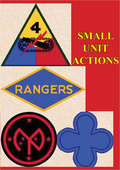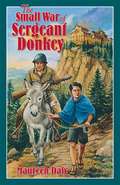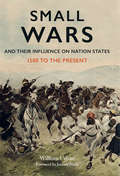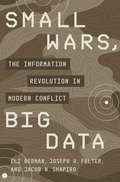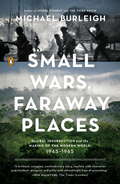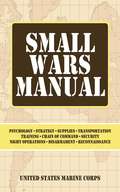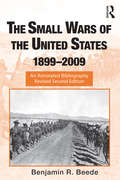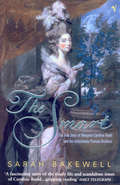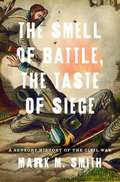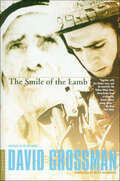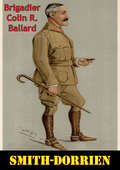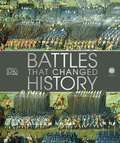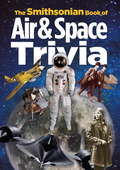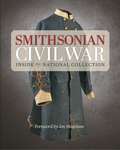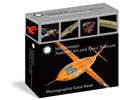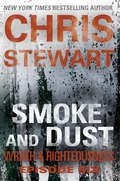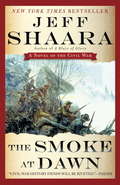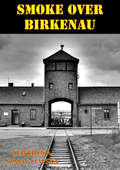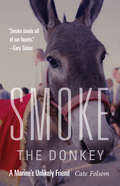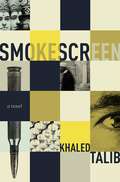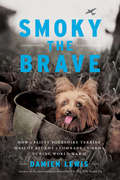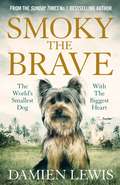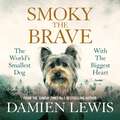- Table View
- List View
Small Unit Actions [Illustrated Edition]
by AnonIncluded are more than 70 photos and maps.There are several reasons that justify such a publication. The most important is to give both the military reader and the American public solid, uncolored material for a better understanding of the real nature of modern battle. Military operations on the scale of this war if treated, as they must usually be, in terms of armies and corps, can give only an outline account of the fortunes of units smaller than a battalion, and very often the battalion is treated as the smallest counter in the moves described on a battlefield. This tends to be misleading; a battalion has no such unity as a battleship, but is a complex organism that maneuvers ordinarily on a front half a mile or more in width, includes a variety of specialized weapons, and often has attachments of engineers or tanks to provide greater tactical flexibility. In jungle or hedgerow country, the battalion frequently exists only as a mechanism to coordinate, perhaps with the greatest difficulty, the separate engagements of companies, platoons, or even squads. When the record (or the military history) sums up an action by saying, "The 3d Battalion fought its way forward against heavy resistance for 500 yards," only the man who has himself experienced combat is likely to realize what this can involve, and what the phrase conceals. It does not give the story of the front line action as experienced by the combat soldier. That story, hardest of all military operations to recapture and make clear, lies in detail such as that offered by the narratives presented here.The actions described in vivid and excellent detail are;France: 2d Ranger Battalion at Pointe du HocSaipan: 27th Division on Tanapag PlainItaly: 351st Infantry at Santa Maria InfanteFrance: 4th Armored Division at Singling
The Small War of Sergeant Donkey (Living History Library)
by Maureen Daly Wesley DennisDonkeys by the hundreds! Twelve-year-old Chico Filippo, whose own donkeys were confiscated years before by the German army, can t stay away from the newly set up American Remount Depot. Here, in the last months of World War II in Italy, thousands of supply mules and donkeys are processed and sent onto the fierce mountain fighting in the Apennines. One of the handlers introduces Chico to a small courageous animal the boy names Sergeant Donkey. Drawn into friendship and then into unexpected danger, Chico must demonstrate his own simple courage. More than an animal or war story, this short book has a depth of truth about people of different ages and nationalities who still share a common love of the land and of human dignity. Age 8-up
Small Wars and Their Influence on Nation States: 1500 to the Present
by William UrbanAfter 1500, European warfare was repeatedly revolutionized by new weapons, new methods for supplying armies in the field, improved fortifications and new tactics for taking fortifications. This allowed empires to grow, with, for example, the Ottomans expanding into the Middle East and Africa, Britain dominating India, and Russia conquering the steppe.The dynamics of resistance to this expansion were remarkably similar to what we see today in ISIS, Afghan and Pakistani Talibans, and various jihadist groups that are more tribal than Islamist. The driving force behind these organizations may be tribal resentment of the modern world undermining long-established traditions and beliefs. Religion or their interpretation of Islam is merely a glue that holds the rebels together.Such resistance continues to be met by world powers who misunderstand the motives of the people that take up arms against them, and we should understand that ours is not the first generation to deal with this problem, and ours will probably not be the last. However, there are some methods that work better than others. The failures and successes of the past can help us now and in the future.
Small Wars, Big Data: The Information Revolution in Modern Conflict
by Eli Berman Joseph H. Felter Jacob Shapiro Vestal McIntyreHow a new understanding of warfare can help the military fight today’s conflicts more effectivelyThe way wars are fought has changed starkly over the past sixty years. International military campaigns used to play out between large armies at central fronts. Today's conflicts find major powers facing rebel insurgencies that deploy elusive methods, from improvised explosives to terrorist attacks. Small Wars, Big Data presents a transformative understanding of these contemporary confrontations and how they should be fought. The authors show that a revolution in the study of conflict--enabled by vast data, rich qualitative evidence, and modern methods—yields new insights into terrorism, civil wars, and foreign interventions. Modern warfare is not about struggles over territory but over people; civilians—and the information they might choose to provide—can turn the tide at critical junctures.The authors draw practical lessons from the past two decades of conflict in locations ranging from Latin America and the Middle East to Central and Southeast Asia. Building an information-centric understanding of insurgencies, the authors examine the relationships between rebels, the government, and civilians. This approach serves as a springboard for exploring other aspects of modern conflict, including the suppression of rebel activity, the role of mobile communications networks, the links between aid and violence, and why conventional military methods might provide short-term success but undermine lasting peace. Ultimately the authors show how the stronger side can almost always win the villages, but why that does not guarantee winning the war. Small Wars, Big Data provides groundbreaking perspectives for how small wars can be better strategized and favorably won to the benefit of the local population.
Small Wars, Faraway Places
by Michael BurleighA sweeping history of the Cold War’s many "hot” wars born in the last gasps of empire The Cold War reigns in popular imagination as a period of tension between the two post-World War II superpowers, the United States and the Soviet Union, without direct conflict. Drawing from new archival research, prize-winning historian Michael Burleigh gives new meaning to the seminal decades of 1945 to 1965 by examining the many, largely forgotten, "hot” wars fought around the world. As once-great Western colonial empires collapsed, counter-insurgencies campaigns raged in the Philippines, the Congo, Iran, and other faraway places. Dozens of new nations struggled into existence, the legacies of which are still felt today. Placing these vicious struggles alongside the period-defining United States and Soviet standoffs in Korea, Vietnam, and Cuba, Burleigh swerves from Algeria to Kenya, to Vietnam and Kashmir, interspersing top-level diplomatic negotiations with portraits of the charismatic local leaders. The result is a dazzling work of history, a searing analysis of the legacy of imperialism and a reminder of just how the United States became the world’s great enforcer. .
Small Wars Manual: The Official U. S. Marine Corps Field Manual, 1940 Revision
by United States Marine Corps.Originally published in 1940 by the U.S. Marine Corps, this book examines the practical and philosophical aspects of low-intensity conflicts, which were then referred to as 'Small Wars.' This is one of the best books on military peacekeeping and counterinsurgency operations published before World War II. As an historical artifact, it offers insight to a rarely seen and often overlooked period in American history. Topics include strategy, psychology, dealings with foreign civilians, as well as implementation of a democratically-elected government. A great addition to the library of any historian, military man or concerned citizen!
The Small Wars of the United States, 1899-2009: An Annotated Bibliography (Routledge Research Guides to American Military Studies)
by Benjamin R. BeedeThe Small Wars of the United States, 1899–2009 is the complete bibliography of works on US military intervention and irregular warfare around the world, as well as efforts to quell insurgencies on behalf of American allies. The text covers conflicts from 1898 to present, with detailed annotations of selected sources. In this second edition, Benjamin R. Beede revises his seminal work, bringing it completely up to date, including entries on the current conflicts in Iraq and Afghanistan. An invaluable research tool, The Small Wars of the United States, 1899–2009 is a critical resource for students and scholars studying US military history.
The Smart
by Sarah BakewellThe Smart is a true drama of eighteenth-century life with a mercurial, mysterious heroine. Caroline is a young Irishwoman who runs off to marry a soldier, comes to London and slides into a glamorous life as a high-class prostitute, a great risk-taker, possessing a mesmerising appeal. In the early 1770s, she becomes involved with the intriguing Perreau twins, identical in looks but opposite in character, one a sober merchant, the other a raffish gambler. They begin forging bonds, living in increasing luxury until everything collapses like a house of cards - and forgery is a capital offence. A brilliantly researched and marvellously evocative history, The Smart is full of the life of London streets and shots through with enduring themes - sex, money, death and fame. It bridges the gap between aristocracy and underworld as eighteenth-century society is drawn into the most scandalous financial sting of the age.
Smart Grid Security: An End-to-End View of Security in the New Electrical Grid
by Gilbert N. Sorebo Michael C. EcholsThe Smart Grid has the potential to revolutionize electricity delivery systems, and the security of its infrastructure is a vital concern not only for cyber-security practitioners, engineers, policy makers, and utility executives, but also for the media and consumers. Smart Grid Security: An End-to-End View of Security in the New Electrical Grid ex
The Smell of Battle, The Taste of Siege: A Sensory History of the Civil War
by Mark M. SmithHistorical accounts of major events have almost always relied upon what those who were there witnessed. Nowhere is this truer than in the nerve-shattering chaos of warfare, where sight seems to confer objective truth and acts as the basis of reconstruction. In The Smell of Battle, the Taste ofSiege, historian Mark M. Smith considers how all five senses, including sight, shaped the experience of the Civil War and thus its memory, exploring its full sensory impact on everyone from the soldiers on the field to the civilians waiting at home. From the eardrum-shattering barrage of shells announcing the outbreak of war at Fort Sumter; to the stench produced by the corpses lying in the mid-summer sun at Gettysburg; to the siege of Vicksburg, once a center of Southern culinary aesthetics and starved into submission, Smith recreates howCivil War was felt and lived. Relying on first-hand accounts, Smith focuses on specific senses, one for each event, offering a wholly new perspective. At Bull Run, the similarities between the colors of the Union and Confederate uniforms created concern over what later would be called "friendlyfire" and helped decide the outcome of the first major battle, simply because no one was quite sure they could believe their eyes. He evokes what it might have felt like to be in the HL Hunley submarine, in which eight men worked cheek by jowl in near-total darkness in a space 48 inches high, 42inches wide. Often argued to be the first "total war," the Civil War overwhelmed the senses because of its unprecedented nature and scope, rendering sight less reliable and, Smith shows, forcefully engaging the nonvisual senses. Sherman's March was little less than a full-blown assault on Southernsense and sensibility, leaving nothing untouched an no one unaffected. Unique, compelling, and fascinating, The Smell of Battle, The Taste of Siege, offers readers way to experience the Civil War with fresh eyes.
The Smile of the Lamb: A Novel
by David GrossmanIn a chorus of voices David Grossman's The Smile of the Lamb tells the story of Uri, an idealistic young Israeli soldier serving in an army unit in the small Palestinian village of Andal, in the occupied territories, and his relationship with Khilmi, a nearly blind old Palestinian storyteller. Gradually as the violent reality of the occupation that infects both the occupier and the occupied alike merges with the old man's stories, Uri, captivated by Khilmi's wisdom, tries to solve the riddles and deceits that make up his life.Originally published in Hebrew in 1983, The Smile of the Lamb is a novel of disillusionment and a piercing examination of injustice and dishonesty.
Smiling for Strangers
by Gaye HicyilmazDuring the war, fourteen-year-old Nina flees from her village in Yugoslavia, armed only with some letters and a photograph, to search for an old friend of her mother's in England.
Smith-Dorrien [Illustrated Edition]
by Brigadier Colin R. BallardIncludes 17 maps and the First World War Illustrations Pack - 73 battle plans and diagrams and 198 photosIn this volume, Brigadier Ballard, provides a detailed biography and defence of his former commander, General Horace Smith-Dorrien.'With the outbreak of war Smith-Dorrien, who was a veteran of the 1879 Battle of Isandhlwana and the Second Boer War of 1899-1902, was given command of II Corps of Sir John French's British Expeditionary Force (BEF). He was praised for his conduct during the Battles of Mons and Le Cateau in August 1914, and was given command of Second Army from December 1914 to April 1915.Smith-Dorrien fell foul of Sir John French, whom he little respected, during the Second Battle of Ypres, when he recommended a strategic withdrawal closer to Ypres, feeling that nothing short of a major counter-offensive was likely to regain the ground taken by the Germans during their offensive.French disagreed, dismissing Smith-Dorrien home to England upon the pretext of ill-health, and replacing him with Herbert Plumer, who ironically also recommended a withdrawal upon taking up his position; French accepted Plumer's advice.'-Michael Duffy
Smithsonian: Battles that Changed History (DK History Changers)
by DKFrom the fury of the Punic Wars to the icy waters of Dunkirk, relive 5,000 years of world-changing combat with this guide to the most famous battles in history. This military history book takes you on a journey through the battlefields of history, from the ancient world to the American Civil War, World War 1, World War 2, the Cold War, and beyond. Maps, paintings, and photographs reveal the stories behind more than 90 of the most important battles ever to take place, and show how fateful decisions led to glorious victories and crushing defeats. From medieval battles and great naval battles to the era of high-tech air battles, key campaigns are illustrated and analyzed in detail – the weapons, the soldiers, and the military strategy. Dive into the past to discover: - Specially commissioned maps show how each of the featured battles played out.- Entries tell the story behind each battle – why it happened, and the lasting historical impact it left on both the parties involved and the wider world.- Chapter directory sections cover other key battles of the period bringing the total number of battlesFamous military leaders are profiled, including Alexander the Great, Napoleon, and Rommel, and crucial arms, armor, and equipment are explained. Whether at Marathon, Agincourt, Gettysburg, or Stalingrad, Battles that Changed History takes you into the thick of combat and shows how kingdoms and empires have been won and lost on the battlefield. A must-have volume for history and military history enthusiasts, university students, and armchair generals of all ages.
The Smithsonian Book of Air & Space Trivia
by Smithsonian Institution Amy PastanWho was the first person to dine in space? How long was the Wright brothers's first successful flight? What famous aircraft was named after a grape-flavored soft drink? What toy based on an animated film accompanied astronauts on a shuttle mission in 2000? These questions and many more are answered in The Smithsonian Book of Air & Space Trivia. In addition to the canon of space and aviation information, the pages are illustrated with more than 125 objects from the Smithsonian National Air and Space Museum's collections.
Smithsonian Civil War: Inside the National Collection
by Jon Meacham Michelle Delaney Smithsonian Institution Hugh Talman Neil KaganSmithsonian Civil War is a lavishly illustrated coffee-table book featuring 150 entries in honor of the 150th anniversary of the Civil War. From among tens of thousands of Civil War objects in the Smithsonian's collections, curators handpicked 550 items and wrote a unique narrative that begins before the war through the Reconstruction period. The perfect gift book for fathers and history lovers, Smithsonian Civil War combines one-of-a-kind, famous, and previously unseen relics from the war in a truly unique narrative.Smithsonian Civil War takes the reader inside the great collection of Americana housed at twelve national museums and archives and brings historical gems to light. From the National Portrait Gallery come rare early photographs of Stonewall Jackson and Ulysses S. Grant; from the National Museum of American History, secret messages that remained hidden inside Lincoln's gold watch for nearly 150 years; from the National Air and Space Museum, futuristic Civil War-era aircraft designs. Thousands of items were evaluated before those of greatest value and significance were selected for inclusion here. Artfully arranged in 150 entries, they offer a unique, panoramic view of the Civil War.
Smithsonian National Air and Space Museum Photographic Card Deck: 100 Treasures from the World's Largest Collection of Air and Spacecraft
by Dwight Jon ZimmermanCreated in partnership with the world-renowned Smithsonian National Air and Space Museum, this beautifully packaged, informative card deck captures, in words and stunning photographs, 100 of the museum's most important artifacts. The NASM is the world's largest, most-visited collection of historical aircraft and spacecraft, and commemorate major milestones in flight and space exploration. The 100 treasures in this deck, hand-selected by the curators, include the Spirit of St. Louis, flown by Charles Lindbergh on the first non-stop transatlantic flight; Chuck Yeager's Bell X-1, in which he broke the sound barrier; Buzz Aldrin's space suit, worn during the Apollo 11 mission, and the Space Shuttle Discovery, which flew 39 missions and spent 365 days in space. Each card includes a photograph of the object on the front and a 200-word description plus key data on the back.
Smoke and Dust: Episode Six
by Chris Stewart"It really grips you....I lost a lot of sleep reading it." -Tim LaHaye, co-author of the LEFT BEHIND series CHAOS REIGNS "The freeway was a mass of stalled cars. Virtually nothing moved. Some of the people still waited in their vehicles, convinced the government was going to send someone out to save them--to pick them up and drive them home. Most of the drivers and passengers, however, had finally started walking, and the freeway was crowded with weary people moving along the unending line of cars." As the scale of the EMP attack on America becomes clear, society begins to break down. Tens of millions of people are instantly homeless, stranded on freeways or in airports that have gone silent. There is no food, no water, no rule of law. Sam and Bono, U.S. Army Special Forces soldiers who made it back to the States just before the attack, are two of those wandering the streets, searching for their families. But with no means of communication and transportation options severely limited, they are getting nowhere fast. Meanwhile, halfway across the country, Sam's family has come face to face with evil and is struggling to survive. Can Sam find them in time, or will this epic war claim its latest victim? Against the backdrop of torn-from-the-headlines Middle Eastern drama, the Wrath & Righteousness series is a fast-paced thriller that explores man's role in the eternal battle between good and evil. Chris Stewart is the New York Times bestselling author of several books, including The Miracle of Freedom. He is a world-record-setting Air Force pilot (fastest nonstop flight around the world) and president and CEO of The Shipley Group, a nationally recognized consulting and training company. Wrath & Righteousness is a ten episode e-book series by New York Times bestselling author Chris Stewart. Each episode is approximately 50,000-60,000 words (roughly two-thirds the length of a normal full-length novel). This series was adapted from the previously published The Great and Terrible series that was released from 2003-2008.
The Smoke at Dawn
by Jeff ShaaraNew York Times bestselling author Jeff Shaara returns to the Civil War terrain he knows so well, with the latest novel in the series that started with A Blaze of Glory and A Chain of Thunder. In The Smoke at Dawn, the last great push of the Army of the Cumberland sets the stage for a decisive confrontation at Chattanooga that could determine the outcome of the war. Summer, 1863. The Federal triumph at Vicksburg has secured complete control of the Mississippi River from the Confederacy, cementing the reputation of Ulysses S. Grant. Farther east, the Federal army under the command of William Rosecrans captures the crucial rail hub at Chattanooga. But Rosecrans is careless, and while pursuing the Confederates, the Federal forces are routed in north Georgia at Chickamauga Creek. Retreating in a panic back to Chattanooga, Rosecrans is pursued by the Confederate forces under General Braxton Bragg. Penned up, with their supply lines severed, the Federal army seems doomed to the same kind of defeat that plagued the Confederates at Vicksburg. But a disgusted Abraham Lincoln has seen enough of General Rosecrans. Ulysses Grant is elevated to command of the entire theater of the war, and immediately replaces Rosecrans with General George Thomas. Grant gathers an enormous force, including armies commanded by Joseph Hooker and Grant's friend, William T. Sherman. Grant's mission is clear: Break the Confederate siege and destroy Bragg's army. Meanwhile, Bragg wages war as much with his own subordinates as he does with the Federals, creating dissension and disharmony in the Southern ranks, erasing the Confederate army's superiority at exactly the wrong time. Blending evocative historical detail with searing depictions of battle, Jeff Shaara immerses readers in the world of commanders and common soldiers, civilians and statesmen. From the Union side come the voices of Generals Grant, William Tecumseh Sherman, and George Thomas--the vaunted "Rock of Chickamauga"--as well as the young private Fritz "Dutchie" Bauer. From the Rebel ranks come Generals Bragg, Patrick Cleburne, and James Longstreet, as well as the legendary cavalry commander, Nathan Bedford Forrest. A tale of history played out on a human scale in the grand Shaara tradition, The Smoke at Dawn vividly recreates the climactic months of the war in the West, when the fate of a divided nation truly hangs in the balance. Praise for Jeff Shaara's new Civil War series A Blaze of Glory "Brilliant . . . riveting . . . a work to be embraced."--Bookreporter "[An] exciting read . . . This novel is meticulously researched and brings a vivid reality to the historical events depicted."--Library Journal "Dynamic portrayals [of] Johnston, Grant and William Tecumseh Sherman."--The Wall Street Journal A Chain of Thunder "[A] riveting fictional narrative."--Booklist "Shaara continues to draw powerful novels from the bloody history of the Civil War. . . . [He] aptly reveals the main actors: Grant, stoic, driven, not given to micromanagement; Sherman, anxious, high-strung, engaged even when doubting Grant's strategy. . . . Worth a Civil War buff's attention."--Kirkus Reviews "Shaara's historical accuracy is faultless, and he tells a good story. . . . The voices of these people come across to the reader as poignantly clear as they did 150 years ago."--Historical Novels Review
Smoke Over Birkenau [Illustrated Edition]
by Jadwiga Rynas Seweryna SzmaglewskaIncludes 204 photos, plans and maps illustrating The HolocaustArrested by the Gestapo in 1942 for involvement in the resistance, the author spent three years in Birkenau. Severyna Szmaglewska (1916-1992) began writing this book immediately after escaping from an evacuation transport in January 1945, and it is the first account of the Auschwitz-Birkenau camp and an eloquent and important analysis of the individual experience of modern war. It was ready for print before the end of 1945, after several months of feverish work. In February 1946 the International Tribunal in Nuremberg included it in the material making up the charges against the Nazi perpetrators, and called upon the author to give testimony. Since 1945, Smoke over Birkenau has been reprinted frequently and widely translated. Critics, and three generations of readers, praised it for truthfulness, accuracy, and lasting literary merit: as memories of war-time genocide fade with the passage of time, Szmaglewska's readers are able to stay in touch with extremes of experience which must never be forgotten. "Smoke over Birkenau is not a book about death or hatred," one critic wrote. "It is a powerful act of the will to live and a profession of the noblest humanism. The victorious idea of life is woven through every page. Maintaining, cultivating, and instilling in oneself the imperative: You must endure! You must live! - a plan carried out unswervingly despite everything."-Print ed.
Smoke the Donkey: A Marine's Unlikely Friend
by Cate Folsom Robert R. RuarkOn a U.S. military base near Fallujah in war-torn Iraq, Col. John Folsom woke up one morning to the sound of a small, scruffy donkey tied up outside his quarters. He was charmed by this scrawny animal with a plaintive expression. Folsom and his fellow Marines took in the donkey, built him a corral and shelter, and escorted him on daily walks. One night, hanging out with the Marines as they relaxed after work, the donkey snatched someone’s lit cigarette and gobbled it up, to the laughter of all. Suddenly, the donkey had a name: Smoke. More than a conversation topic for troops connecting with families back home, Smoke served as mascot, ambassador, and battle buddy. Smoke the Donkey recounts the strong friendship between Colonel Folsom and this stray donkey and the massive challenges of reuniting Smoke with Folsom in the United States following Folsom’s retirement. After being given to a local sheik, Smoke wandered the desert before Folsom rallied an international team to take him on a convoluted journey to his new home. The team won a protracted bureaucratic battle to move Smoke from Iraq to Turkey, only to face a tougher fight getting him out of Turkey. Once in the States, Smoke became a beloved therapy animal for both children and veterans. Smoke’s story, while tinged with sadness, speaks to the enduring bond between a man and an animal, unbroken by war, distance, or red tape.
Smokescreen
by Khaled TalibAt an ancient café in Cairo, two veteran spies plot a covert mission to resolve -- once and for all -- the Israeli - Palestinian conflict. The pledge: Israel will make a major concession as part of the peace treaty. In Singapore, Jethro Westrope, a magazine journalist, stumbles onto the scene of a murder: the beautiful Niki Kishwani directs him, in her last breath, to a digital recorder, evidence that puts Jethro's life in serious danger. And, much worse, he is framed for Niki's murder. Jethro sets out to find Niki's killer and is drawn into a web of deception and intrigue involving officials from the Singaporean, Israeli, and American governments, each with a complex, competing, and potentially deadly agenda. Against this pulse-pounding backdrop, Jethro races to find answers and save himself --yet nothing is as it seems. He finds himself at the center of a political plot so diabolical and sweeping in its world implications that he is stunned to discover tomorrow's news headlines today. He is being set up not only as a murderer but as an assassin, and something much larger than his own fate is in his hands.
Smoky the Brave: How a Feisty Yorkshire Terrier Mascot Became a Comrade-in-Arms during World War II
by Damien LewisThe extraordinary, touching true story of Smoky, the smallest--and arguably bravest--dog of World War IIIn February 1944, as Japanese military advances threatened to overwhelm New Guinea, a tiny, four-pound Yorkshire Terrier was discovered hiding in the island's thick jungles. A total mystery as to her origins, she was adopted by US Army Air Force Corporal William "Bill" Wynne, an air-crewman in a photo reconnaissance squadron, becoming an irreplaceable lucky charm for the unit. When Smoky saved Wynne's life by barking a warning of an incoming kamikaze attack, he nicknamed her the "angel from a foxhole." Smoky's exploits continued when she jumped for the unit in a specially designed parachute and famously joined the aircrews flying daring sorties in the war-torn skies. But her most heroic feat was running a cable through a seventy-foot pipe no wider than four inches in places to enable critical communication lines to be run across an airbase which had just been seized from the enemy, saving hundreds of ground-crew from being exposed to enemy bombing.In recognition of her efforts, Smoky was awarded eight battle stars. Smoky the Brave brings to vivid life the danger and excitement of the many missions of World War II's smallest hero.
Smoky the Brave
by Damien LewisThe World's Smallest Dog with the World's Biggest HeartSmoky the Brave is the extraordinary, touching and true story of a heroic dog and her adoptive masters in the jungles of the Pacific War. In February 1944, as Japanese military advances threatened to engulf Australasia, a tiny, four-pound Yorkshire terrier was discovered hiding in a Japanese shell scrape amidst the thick jungles of Papua New Guinea. The GIs who discovered her presumed she had been some kind of Japanese army mascot, but it soon turned out that she understood neither commands rendered in Japanese nor English. A mystery, she was adopted by Corporal William 'Bill' Wynne, an air-crewman with the US 5th Air Force's 26th Photo Reconnaissance Squadron.Living in Bill Wynne's tent, sleeping on a piece of green felt salvaged from a card table,and sharing his rations, Smoky became the de facto mascot of the regiment. She went on to fly numerous photo-recce and air-sea rescue missions, cocooned in a soldier's pack hanging next to the machine-guns used to repel marauding Japanese fighters. She was awarded eight battle stars, surviving dozens of Japanese combat raids on Papua New Guinea, and braving a typhoon that ravaged Okinawa. After saving Wynne's life by warning of a falling shell, as their landing craft approached an enemy-held beach - a shell that killed the eight men that Wynne was standing beside - he nicknamed her the 'angel from a foxhole'. In one of her most famous exploits Smoky parachuted using a special rig designed to fit one of the world's smallest but toughest dogs.In perhaps her most heroic exploit of all, Smoky ran a cable through a seventy-foot pipe no wider in places than four inches, to enable telephone lines to be run across the recently occupied airbase of Luzon. Her efforts saved hundreds of ground-crew from being exposed to enemy bombing, preventing injury and loss of life. Amongst her many other awards,she was given the PDSA's Certificate for Animal Bravery or Devotion in 2011, a relatively new class of PDSA award.
Smoky the Brave
by Damien LewisThe World's Smallest Dog with the World's Biggest HeartSmoky the Brave is the extraordinary, touching and true story of a heroic dog and her adoptive masters in the jungles of the Pacific War. In February 1944, as Japanese military advances threatened to engulf Australasia, a tiny, four-pound Yorkshire terrier was discovered hiding in a Japanese shell scrape amidst the thick jungles of Papua New Guinea. The GIs who discovered her presumed she had been some kind of Japanese army mascot, but it soon turned out that she understood neither commands rendered in Japanese nor English. A mystery, she was adopted by Corporal William 'Bill' Wynne, an air-crewman with the US 5th Air Force's 26th Photo Reconnaissance Squadron.Living in Bill Wynne's tent, sleeping on a piece of green felt salvaged from a card table, and sharing his rations, Smoky became the de facto mascot of the regiment. She went on to fly numerous photo-recce and air-sea rescue missions, cocooned in a soldier's pack hanging next to the machine-guns used to repel marauding Japanese fighters. She was awarded eight battle stars, surviving dozens of Japanese combat raids on Papua New Guinea, and braving a typhoon that ravaged Okinawa. After saving Wynne's life by warning of a falling shell, as their landing craft approached an enemy-held beach - a shell that killed the eight men that Wynne was standing beside - he nicknamed her the 'angel from a foxhole'. In one of her most famous exploits Smoky parachuted using a special rig designed to fit one of the world's smallest but toughest dogs.In perhaps her most heroic exploit of all, Smoky ran a cable through a seventy-foot pipe no wider in places than four inches, to enable telephone lines to be run across the recently occupied airbase of Luzon. Her efforts saved hundreds of ground-crew from being exposed to enemy bombing, preventing injury and loss of life. Amongst her many other awards, she was given the PDSA's Certificate for Animal Bravery or Devotion in 2011, a relatively new class of PDSA award.(P)2018 Quercus Editions Limited
